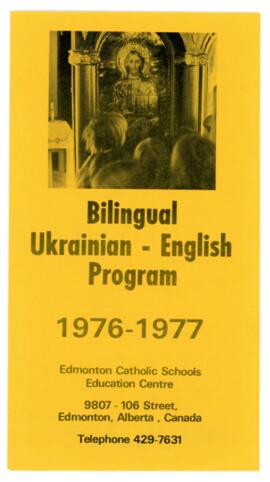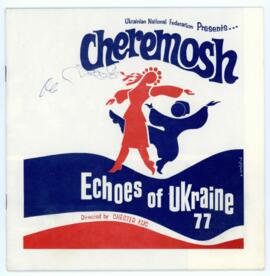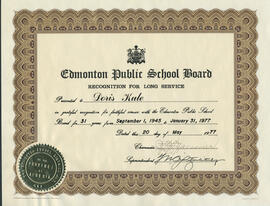- E.W.Yarenco. “Steve and Lucy Hrabec.”
- Hryhorii i Stefaniia Yopyk. “Shcho stalosia z koronoiu korolia Danyla?” Edmonton, osin', 1977.
- H. Yopyk. [about Iv. Borukh]
- "Our Life" - New York - 1977-06-03, 1980-06-23
- " Ukrainian News" - Edmonton - 1981 and greeting cards
- " Litopys UPA" - Toronto - 1982
- " Smoloskyp" - Toronto - 1982-11, 1983-10, 1983-11
- English language program for 13th Annual Western Conference in Winnipeg: 1977
- Constitution of the Ukr-Can Students Union", 1971-08, amended 1977-08
- 25th Anniversary Booklet: 1978
- Program of the 19th SUSK congress in Winnipeg
- Letter to Myron Lahola.
Includes a brochure on a bilingual Ukrainian-English program offered by Edmonton Catholic Schools, and a more in-depth document discussing the fees and advantages of the program.
This project describes a collection of folk remedies for common illnesses from an interview taken in 1977.
A collection of proverbs relating to folk medicine.
Final essay on Drahomanov's collection of Ukrainian political songs circa 1709-1739 by Yarema Kowalchuk for course UKR 699.
This item contains 10 files of audio from an interview conducted by Art Stelter with his father Dan Stelter. Topics discussed include Dan's father coming to Canada, because he had to work for 30-35 rubles a month for a farmer (Polish or Russian) on a contract. A worker could not leave unless found another person to take over his contract. His father worked in Ukraine but was born in Poland. Was 12 years old when moved to Zhytomyr area. His dad was a Prussian. His father’s parents moved from Poland to Ukraine because Russians wanted German settlers to develop their land. Many German farmers were possessors of the land, but his father’s family had their land on a lease. Ukrainian farmers being backward comparing to Germans. Living in a village but having 2-5 acreages outside. Schools in villages. Father could not write but was able to read. Lutheran churches. His father married at 16. One child died. About 1886 he emigrated to Winnipeg at age 30. Grandmother Amalia. Women worked cleaning offices. German community in Canada His mother snuck from Poland to Germany on a false passport; left from Hamburg to Liverpool on a boat, then to Quebec. Rough trip on a ship. Marriage without love, just duty. Mother could write in German. In 1918 the family came to Bruderheim. Most Bruderheimers came from Zhytomyr. Moravians and their church in Bruderheim. Shwartz was the first church minister. Family had 25-30 horses, 250 acres of land. Sold everything in the fall of 1927 and moved to Bruderheim with a big sum of cash to avoid bank charge commission. Dan’s Russian background: grandfather Martin [Stuter] lived near Lublin, Poland. Called themselves Prussians but considered themselves German. But they could have been from Austria. Dan’s grandfather was the youngest in his family. Janott’s mother was Dan’s grandmother. Married a guy named Kobus. Came to Kelowna. Athabasca [Stulters]. Ludwig and Jastina moved from Lublin to Ukraine in 1867 to get a new life. Lutheran church was responsible for finding settlements. Not all families moved to Bruderheim after WWI. 100 years exempt from military service. Clergy: [Shwanke]. Martin was never a citizen of Russia, lived on rented land of a nobleman. Problem of leaving while having an understanding. When he was 12, they moved to Volyn area, in Zhytomyr. Does not know names of villages or family stories. Martin Dan’s family: Amalia born in 1863. Historical circumstances at that time with Russian occupying lands and leading wars against Poland. Polish reaction against the Germans. Family members were hanged. Family moving to Ukraine at that time. Amalia’s mother was still living when they left for Canada. Wendy, Dan’s mother’s sister, died in Bruderheim in 1951. Russian government pension. Amalia had a brother who went to South America (Brazil). Violence against the Germans in Russia. Mother’s side of family coming to Ukraine via Poland in 1857. School teachers having connection with Volga Germans. [Greenwert]. Danny coming directly from Germany. German accents of people from different areas, distinction of High German vs. Low German. Yiddish as German dialect. His family living in Ukraine for 20 years. His mother’s background: sold most of their belongings to come to Canada. When they came it was Spring. Mom’s father bought a cheap place to live. It turned out to be haunted house. Grandmother was the only one who saw the ghost and heard the steps. [Going back and force between moving to Ukraine and to Canada in his story]. Sold the house and the land for cash to a Polish couple on their way to Canada. The ghost was a man who hung himself. Arrived in March. Grandmother’s brother was in the army and that time and did not want to go to Canada. Came in 1905. Bruderheim. Germans in Medicine Hat. Grandparents speaking languages other than German. Naturalization papers of the family.
They then discussed Dan's life. Young years of Dan. Having typhoid as a child. School years of Dan: good at math. A year in Edmonton, Medicine Hat, another year in [Newberg]. Leaning English, prohibition to speak German on school grounds. Finished grade 7 in [Newberg]. Farm work on acres. Reading in German. Identifying birds through a book he got as a gift from a Bishop. Playing sports (baseball). Reading books on Canadian folklore (stories) and German literature (religions, war stories) at home (buying them from a travelling salesmen). Publishing house of Minnesota Germans. German newspapers in Canada.
Family raising cattle of different breeds. Father retired from [Newberg], bought a house in Medicine Hat in 1970. Population there was about 20K people. School in Medicine Hat. Selling the farm. School closed up. Churches his family visited. Moravian Brothers in Poland and Russia. Minister from a Moravian church came to the family to baptize Dan. No regular religious community. Dan stay home till almost 20 y.o., then went to USA and stayed there till 23 y.o. Dan in Michigan for 7 years (construction work mostly, for car companies). Laid off during the Depression. Dan applied for American citizenship. Visiting America, difference of American way.
Farming in Bruderheim. The estate was developed by a Ukrainian who did not built anything on it and was forced to sell the land because a cancellation was reported on his land. A story of a curse that Ukrainian had, broke his leg. Inside story was that he was drinking, fell of the truck and broke his neck. Building various buildings on the land (chicken house, barn, etc). The farm was bought in 1931 for $3000 (2 mortgages of 6%). In 1944 he paid off the second mortgage. The interest was cancelled. [Herman Hendrik] helped him not to lose the farm. A loan from a federal government to pay off the first mortgage. [Abraham] made a motion against the mortgages for farmers. When he started farming in 1931 he started with nothing (no equipment or cattle), married in a year. Then bought horses for $150, another for $50 (on a credit). In 1932, oats were about 6 cents a bushel. He bought a buggy. Got Ribbon (a horse) in 1933 who turned white when was about 6 y.o. Had several cows. Bought one for $16. A bull in the neighborhood for the cows. Returning to Canada broke, to a farm. Crop prices during the Depression (30 cents a bushel). Liberal views. Dan’s first voting in 1935 in Provincial Election. Listening to [Eibrahard] on radio. Major Douglas in Ottawa, socialist. Labor Movement. [Walter Cuhl] a member of Parliament. Uncle Fred involved in politics and Social Credit idea: government giving the banks power, giving national loans. Local leaders in Bruderheim in social credits: [Bas Wirsky] who had a hardware store, UFM members from Kuts, Baker, [Bill Tomski], Toman (a school teacher). Social Credit Board. Social Credit Party progressiveness. East exploiting the West. SCP as a popular movement, its influence on government and politics. [Peter Stefora].
Surface Rental Rights Owners’ Association, 1949-1951: Alberta, farms around Bruderhaiem – the government owned all the minerals rights. Leduc, Red Water area, Calmar. Oil companies paid 1%, the government expected 12% payback. Farmers’ Union went on 5%. Oil companies buying farmers’ lands. Saskatchewan farmers’ being paid too little. Pressure on the government from the oil companies.
2 examination booklets for Ukr. 401 and Ukr. 402 from 1977. With grades and comments. Professor - Dr. Bohdan Medwidsky.
Cyncar, NadiaContains a number of items related to the Ukrainian Greek Catholic Church in Canada and Ukraine. There are many newspaper clippings and articles detailing news and ongoings surrounding the church. Significant attention is paid to church activities under Soviet rule.
This series contains records related to Dr. Medwidsky activities within the Folklore Studies Association of Canada, including his term as a President, as well as in the American Folklore Society. Various information about folklore studies in North America has been compiled by Bohdan Medwidsky and later adapted and used for the Ukrainian Folklore Program at the University of Alberta. His connections with known folklorists such as Robert Bohdan Klymasz and Michael Taft (later of the Library of Congress) are also reflected in this series.
The collection consists of the Ukrainian folk tales collected and translated by Nick Evasiuk, one page of "explanatory remarks & apologies" by Nick, a letter from Nick to George (?), and a reply to Nick and Nettie without signature.
Evasiuk, NickThe recording of the 1977 Yevshan concert that took place in the Centennial Auditorium in Saskatoon, SK consists of 4 different story line pieces: Dawning of Verkhovyna, Dumy moi, Zaporozhs'ka slava, and Vesnianka.
- Dawning of Verkhovyna: Mixed Hutsul dance; Boys Hutsul dance; Girls Hutsul dance; Mixed Hutsul dance)
- Dumy Moi: Kozak dance;Mixed Poltava dance Girls Poltava dance; Mixed Poltava dance; Mixed Poltava duet
- Zaporozhs'ka slava: Girls Poltava dance; Mixed Poltava dance; Mixed Poltava duet; Kozak dance; Harem dance; Fight scene; Mixed Poltava duet; Capture scene; Mixed poltava duet; Fight scene; Returning home
- Vesnianka: Mixed Poltava dance; Girls Poltava dance; Kozak dance; Hopak with encore
The series consists of materials of fundraising in Alberta for the Leonid Pliouchtch family who fled the USSR and emigrated to France.
Iwanusiw, JaroslawThe series consists of general information about Alberta Parents for Ukrainian Education Society (APUE), but also about other parental organizations (Manitoba and Calgary), as well as of the role of parents involved as partners in education. It provides information about the structure, aims, activities of each parental organization (conferences, festivals, carolling, anniversary celebrations and day camps. There are financial records, grants, HR information. correspondence, promotional materials, as well as records on education policy in Alberta.



